|
Patagonia 2011

Introduction
We arrived in Buenos Aires (BA) after the usual mind and body numbing experience which is long haul air travel. All airlines seem to be pretty identical these days but Air France did have very charming flight attendants (in a very French way) and is the only one to offer extra bread rolls with dinner. BA was hot and sunny which was nice and very South European in feel. Our initial attempts to communicate in Spanish were a total failure though - Martin only managed to get 2 beers by using sign language!

The shady streets of Palermo, the neighbourhood where we stayed in Buenos Aires.
We spent our first full day doing a walking tour of the city set out in our guide-book. Much of the city was reminiscent of a somewhat run down French city - it reminded Martin of parts of Marseilles. Food is mainly plainly grilled meats with nothing in the way of sauces and not too many vegetables. The quality of the meat is generally impressive and the red wines we sampled were very good. Mind you after 3 days of a non-stop meat fest in BA even Martin was considering vegetarianism!

The Casa Rosada on the Plaza de Mayo. It’s from these balconies that Juan and Eva Peron and General Galtieri addressed the multitudes in the Plaza.

Inside the Casa Rosada a gallery of pictures of famous South Americans included the iconic photo of Ernesto “Che” Guevara.

An impressive building in downtown BA.
BA has an early 20th century metro system which makes getting around really easy and its cheap - only about 20p a journey. On Sunday we visited San Telmo an older area of the city where there was an antiques market which filled the little square and surrounding streets. There were stalls with antique horn gramophones, glass soda siphons in all colours and bric-a-brac of all descriptions. There were musicians and an aged couple dancing the tango and lots and lots of people. All very enjoyable.

A lovely courtyard in the San Telmo district of BA.

Is this old rusting car on a San Telmo street evidence of lack of road tax in BA?
On Monday we changed some of our traveller’s cheques - strangely this is remarkably difficult to do in Argentina. Normal banks will not touch them and we had to go to American Express BA to do it. Then it was off to the airport again for our flight to the fin del mundo which is how Ushuaia in Tierra del Fuego bills itself. As we emerged from the airport building there we were greeted by tremendous gusts of wind and a temperature about 20 degrees lower than BA.

1. Walks around Ushuaia in Tierra del Fuego (Argentina)
2. Parque Nacional Torres del Paine (Chile)
3. Walks in the Monte Fitzroy area, Parque Nacional los Glaciares (Argentina)
4. The 4 day boat trip through the channels and fiords of Chile.
5. Parque Nacional Alerce Andino (Chile)
6. Parque Nacional Chiloe (Chile)
7. Parque Nacional Puyehue (Chile)
8. Nahuel Huapi Traverse (Argentina)
1. Walks around Ushuaia in Tierra del Fuego (Argentina)

At the Fin del Mundo in Ushuaia.
Ushuaia is a bit like Ullapool in Scotland crossed with Chamonix in France with bits of New Zealand thrown in. It sits in the Beagle Channel with snow dotted mountains on all sides. It is full of designer outdoor shops and restaurants on the main street but rapidly becomes very much more basic as one moves inland. Yakush, our hostel, was comfortable and friendly in a slightly hippy way and was right in the centre. The food on offer in the restaurants tended to be quite dramatically over the top. There were whole spatch-cocked lambs on giant metal frames charring over huge open fires and the King Crabs were the largest crabs we had ever seen. We watched a man jump out of a taxi and bustle into a restaurant carrying a cool box. He then opened the box and proceeded to take out a procession of huge live King Crabs which he held up for the amazed spectators to gawp at before dumping them in a huge tank of sea water.

Evening light on the Beagle Channel at Ushuaia.
Our first walk was to Laguna Esmeralda. We were lucky that the sun came out and it was almost warm. We were really impressed with the scenery - wild, wild mountains on all sides and a milky green/blue glacial lake. Then we did another day walk - this time to 2 lakes and also a 2 day hike camping overnight, again by another lake. Both were really enjoyable, great views and only a few people. The weather changed very rapidly and we experienced both snow blizzards and brilliant warm sunshine. One real bonus was the absence of troublesome insects - perhaps it is just not warm enough for them.

The view back from our furthest point at the Laguna Esmeralda.

Some of the river crossings in Patagonia got a bit tricky!

The Laguna del Caminante where we camped.

View from the Laguna del Caminante.
2. Parque Nacional Torres del Paine (Chile)
Everything was going well and we were all set to move on to our next destination, Puerto Natales ready to do the big trek around Torres del Paine when disaster struck. Well that is a bit of an over statement. All buses to Chile were cancelled due to strikes paralysing Southern Chile. These were the result of protests about a big increase in fuel prices. The border was closed and road-blocks stopped all movement between towns in Chile. No-one was able to predict how long the problems would last, particularly as it all became quite violent and apparently there was a very heavy police and military involvement. Our problem was that we were scheduled to start the Torres del Paine trek and we had booked accomodation and food in advance and also paid for it all up-front. By the begining of the week it was clear that we were not going to be able to do the trek on the dates we had booked. We contacted the agency but they were very unclear as to whether we would be able to get our money back. Finally though just as we thought we would have to try to fly out of Ushuaia and go and do some trekking in he Fitzroy National Park (a very expensive option), the protest was resolved and we managed to get on a bus and get to Puerto Natales in Chile. Fortunately, we were able to re-schedule our bookings for the trek so we didn’t lose out after all. We started walking on the 22nd January and were out for 10 days.
The trek around Torres del Paine National Park went really well. The first day was a day hike from the Refugio Torre Central (more like a luxury hotel than a refuge in the Pyrenees or Corsica!) to the mirador or “lookout” in front of the famous rock towers. The track was incredibly busy but the view at the top was pretty stunning even if the tops of the rock towers were shrouded in mist. The wind though was something else - sometimes the gusts were so strong that they almost knocked you off your feet.

The valley of the Rio Ascensio en route to the Torres del Paine lookout.

The view from the Torres del Paine lookout.

In the VERY comfortable Refugio Torre Central
After this we backpacked for the next 9 days sleeping 7 nights in the tent. We were lucky with our weather, often it was not really windy and we had some good sunny days. The first 5 days of the circuit took us behind the Paine massif where there are far fewer hikers.

Flowers everywhere on Day 2 of the Torres del Paine circuit.
Often the views were quite stunning, at our best campsite, Lago Dixon, we had a fantastic view of part of the Helio Sur ice cap coming right down into the lake.

Lago Dixon.

Lago Dixon.

The glacier tumbling into Laguna de los Perros.

Lovely flowers in the rain.
From Lago Dixon we climbed up to cross the Paso Gardiner, the highest point on the circuit. Again we were lucky that there was very little wind. This pass is notorious for howling gales. From the pass you have a quite incredible view of Glacier Grey, which again is part of Helio Sur (the largest ice cap outside Antarctica and Greenland). This glacier was simply enormous. It stretched away as far as the eye could see, a vast ice river with other glaciers flowing down into it. Some of the glacier ice was a quite incredible deep blue - something ranging from aqua marine to cobalt (this was how Tilly, our resident colour expert, described it). Apparently the colour of the ice depends on how old it is and so how much air is in the ice. The older the ice, the less air and the more blue it is.

Martin at the John Gardiner Pass (1241m).

Tilly overlooking Glacier Grey from the John Gardiner Pass.

On the ladders en route for Refugio Grey.
We then travelled for 2 and a half days alongside the glacier and the lake it feeds into.

The snout of Glacier Grey.

The wild expanse of Glacier Grey.
By this time we were back on what is called the “W” route. This is the shorter trek which most people visiting the park do. So the number of walkers on the path increased dramatically.

The “horns” of Cuernos del Paine from the crowded campsite at Mountain Lodge Paine Grande.
The campsite at Mountain Lodge Paine was like a vast tent city. From here we trekked up the Val Frances which was very impressive but horrendously busy. However, we chose to camp at a site (Campamento Britanico) at the top of the valley- whereas most people camp at the bottom and do the valley as a day hike. So we were able to go to the mirador/lookout at the top of the valley in the evening and early morning when there was nobody else there which was great. We were really lucky to see 2 huemul in the dusk. These are a very rare type of deer with big ‘mickey mouse” ears.

Tilly at the Campamento Britanico.

Bad weather at the Campamento Britanico.

More beautiful flowers.
We saw lots of interesting animals and birds. In this respect Patagonia is better than anywhere else we have visited. What is more the birds and animals do not seem to be scared of people so often it is easy to get quite close and see them really well. On our first day in the park we saw a Patagonian fox which quite casually sauntered up the hiking track and then sat a little above it oblivious of all the hikers furiously clicking away with their cameras. The most common animal is the guanaco which looks like a rather pretty piebald lama - rich chestnut brown and light tan. Apparently they are related to camels and they have something of the same look. Alejendro, our very talkative Chilean host at the hostel in Puerto Natales, said that the population of guanacos in the park stays stable because so many are eaten by the resident Pumas! We were slightly taken aback when we arrived at the Refugio Torre Central to find the chairs in the bar were all upholstered with guanaco hide.

The guanaco, a relative of the camel.
We saw quite a number of Condors wheeling around high in the sky as well as ostriches and flamingos. Our most exciting sighting was of a Magellanic woodpecker - deep blue plumage on its body and a vivid crimson head. Also at Puerto Natales there were lots of black AND white swans, pure white bodies with jet-black necks and heads and bright red beaks.
The other extraordinary thing at Puerto Natales was the behaviour of the packs of dogs roaming the streets. Normally this would be really quite threatening but these dogs just attached themselves to you as you walked through the town trotting alongside or just behind until you disappeared into a shop or bank at which point they would start to follow someone else. Another strange thing about Puerto Natales was the way drivers of huge 4x4s would slow down and wave you across in front of them. Mind you in general we reckon Jeremy Clarkson would love S. Argentina and Chile. It is all huge V8s hammering down endless empty roads.
3. Walks in the Monte Fitzroy area, Parque Nacional los Glaciares (Argentina)
Having finished the Torres del Paine circuit we returned to Puerto Natales and then spent the next 2 days on buses travelling to the Fitzroy Mountains in the Glacier National Park. The landscape on the journey was extra-ordinary. Vast open spaces of semi-desert all brown, yellow and grey with the occasional aquamarine glacial lake. Descending to El Calafate, were we broke the journey, was like entering an oasis. It was full of trees and watered green lawns. The next day we arrived in El Chaltein to start our treks around Fitzroy.

The scenery on the way to El Chaltein.
Health remained pretty good although Martin got attacked by some kind of particularly vicious insect one night on the Torres trek and had an impressive number of huge red bumps all over his body. The other slight problem on the horizon was the boat we had booked to sail on from Puerto Natales to Puerto Montt hit an iceberg (or so the rumour went) and was now out of service. We were just hoping that it would be repaired in time for our voyage!

Monte Fitz Roy (named after the captain of Darwin’s voyage in the Beagle) is the big tall one in the centre (3405m).

Aguja Saint Exupery (named after the author of Le Petit Prince who flew planes for many years for the Aeroposta Argentina (2558m).
We spent almost 2 weeks in the Fitz Roy mountains trekking for 11 days. We were amazingly lucky with our weather - often it is cloudy and misty so views of the mountains disappear. We had mostly glorious hot sun and so a whole lot of terrific views. We started with a 4-day trek to almost the base of Cerro Fitz Roy and then round the back of the same mountain. Some of the paths were very busy but once we started going behind the mountain we were usually on our own. We camped at place called Piedra del Fraile for 2 nights and tried to climb a mountain called Cerro Electrico. We got about three-quarters of the way up but then were defeated by almost vertical scree slopes. We think in retrospect that we had missed the route at this point! However, in our defence, there are no paths there and the maps are worse than useless so route finding can be quite a challenge. Here we were with mountaineers who had come to climb on the glaciers and we had an amusing time talking to 3 Russians, now living in the USA, who climbed part of the way with us.

Martin climbing to the top of Cerro Electrico.

On the other hand maybe not!

Round the back of Monte Fitz Roy.

The Glacier Piedras Blancas in the Fitz Roy massif.
After this we trekked back to El Chaltein and had a day off. Then it was a 2 day trek to Campamento d´Agostini at the base of Cerro Torre - a mountain notorious among mountaineers partly because it is so difficult to climb and partly because of a controversy over the first ascent. An Italian called Cesare Maestri claimed to have got to the top in 1959 but his companion was killed during the descent and the camera with the summit photos was lost. Maestri then returned in 1970 and used a compressor to fix bolts to get up the mountain (generally thought to be bad form!!) but then did not climb the unstable snow mushrooms at the very top. So the first undisputed ascent only occurred in 1974 when a group led by Ferrari climbed the whole thing properly!

The view of Cerro Torre from the Laguna Torre.

A closer view of Cerro Torre from the top of the moraine by the lake.

Couldn’t resist the view the next morning of Cerro Torre.
The trip to d´Agostini and back was quite easy unlike our next 2-day outing.
This was a much less frequently walked route to Laguna Torros. It was much longer and involved 3 river crossings. Going out was OK but by the time we had arrived at the rather desolate campsite huddled beneath a grim cliff the weather had changed with a vengeance. There was a howling gale and pouring rain. Needless to say we were the only people in the campsite that night! After a rather disturbed night - Tilly said that she did not sleep a wink - we packed up and headed off back. It rapidly became clear that a serious amount of rain had fallen overnight (67 mm we later discovered). The path was frequently under water and when we arrived at the first river we found a raging torrent. We waded across OK but then as we approached the second river we found that it had broken its banks and we had to wade through knee-deep water just to get to the log which spanned the deep and fast flowing stream. This log was now 6 inches under water and very tricky to negotiate. Martin managed to scramble across but Tilly slipped and fell into the raging torrent. Fortunately, Martin managed to grab an arm as she fell and stop her disappearing down the river. With some difficulty Tilly managed to get out but was wet from mid-chest downwards (Martin was only wet from the knee downwards). After this we just went as fast as we could, wading the last river and then walking without a break back to El Chaltein. We covered the walk in four and a half hours when the official time for it was 7 hours but at least this stopped us from getting too cold.
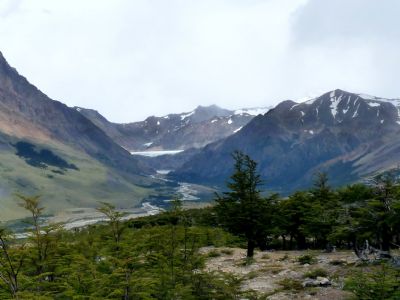
The valley of the Laguna Torros before the weather broke.
We managed to dry out at the hostel in El Chaltein and then took a bus the following day down a dirt road to Lago del Desierto. We planned to walk along the lake then camp at the north end and do another walk the next day before travelling back via the boat which goes up and down the lake twice a day. It rapidly became clear that our plans were going to be frustrated by the still very high water levels. The road to the lake was often under water and when we arrived we found our footpath was under 2 feet of water. We did not fancy more wading since our boots had just dried out so camped at the southern end of the lake and did a short but scenic little route up to Glacier Huemal. The next day we took the boat up and down the lake and then had a really small gentle stroll along the west side of the lake. Then it was back to El Chaltein again for the last time.
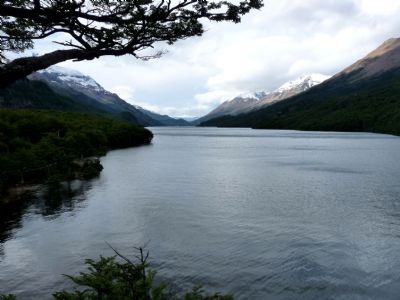
The lovely Largo del Desierto.
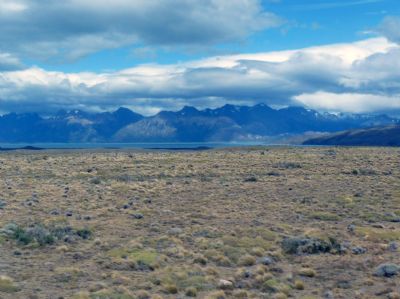
Leaving the Fitz Roy mountains behind.
We then took the bus back to El Calefate and the following day took the tour to the Perito Moreno Glacier. This was a real tourist number but nevertheless very good. The glacier is quite amazing - it is the only major glacier in the world which is in equilibrium apparently so the new ice from the snowfall on the Helio Sur balances out the loss of ice at the snout. It advances at the rate of 2 metres a day and the ice at the snout crashes down into the lake spectacularly every few minutes or so. The glacier is incredibly close to the peninsular of land where all the observation balconies are. The tour also included a boat trip right up to the glacier wall towering 90 metres above the lake.
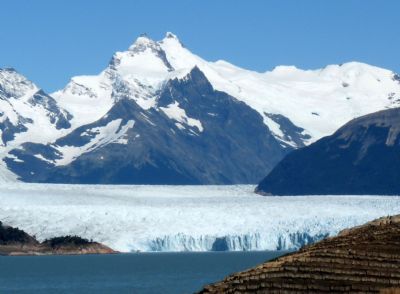
The Perito Moreno glacier.
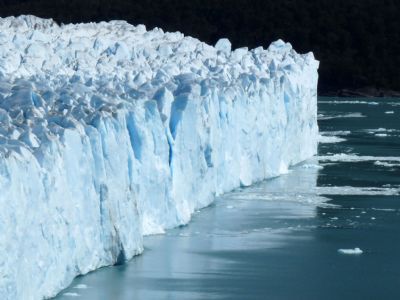
The Perito Moreno glacier.
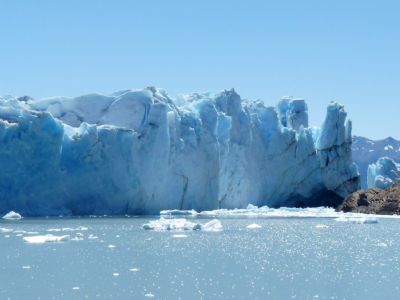
The Perito Moreno glacier.
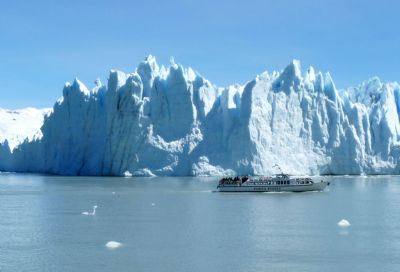
The boats went very close to the Perito Moreno glacier.
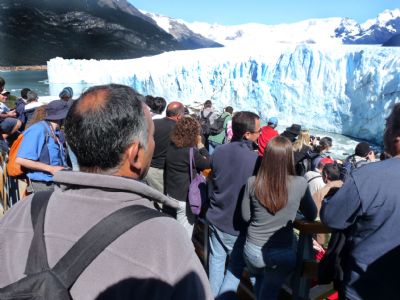
You are not alone! The vewing balconies opposite the snout of the Perito Moreno glacier.
We then had a meal in El Calafate to celebrate Martin’s birthday and tried the famous Patagonian lamb. They spreadeagle a whole sheep on a rack which is then roast at the side of a huge log fire. It was rather a disappointment - nothing like as good as Welsh hill lamb. However, the wine was very good - the Malbecs from Mendoza are really impressive.
4. The 4 day boat trip through the channels and fiords of Chile.
Then it was back on the bus again for the journey back to Puerto Natales in Chile. We got back a day later than we had planned because the buses from El Calafate were all full. This did not matter as the Navimag boat was delayed by 24 hours. Finally on the 22nd February we boarded the boat. It was a roll on/off ferry and they rather bizarrely herded us all onto the lift used for moving cars and lorries onto the upper deck. Then we were lifted majestically up in the air!
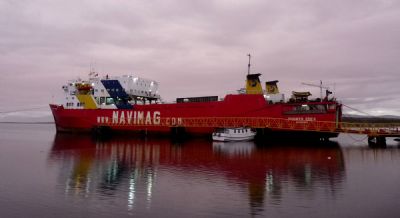
The Navimag ferry.
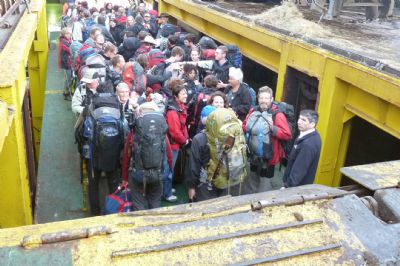
The lorry lift on the Navimag ferry.
We had to share a cabin (originally Tilly had booked us our own cabin) since the replacement boat, Puerto Eden, did not have the kind of cabins we had booked (Navimag promised us a whopping refund which made the prospect of sharing more palatable). The cabin with 4 berths was tiny but it did have a porthole. We were sharing with Harry and Jill from Tasmania. Again we were incredibly lucky with our weather - blue skies and sun the whole 4 days. The scenery on the trip was quite stunning as the boat spends most of the time in the Patagonian fiords. On occasions the boat had to pass through really tiny channels where you could almost touch the islands on both sides. The wildlife sightings were a bit disappointing - the closest we got to seeing whales was the sight of a distant spout of water. The boat crew were very friendly but did not seem terribly efficient. They had an emergency drill and it was like watching a Keystone Cops film. We were glad that the weather was calm and so there was little chance of having to man the lifeboats. Every day we had a really good hour’s lecture on the geography, flora and fauna of Patagonia delivered by a very enthusiastic English speaking “expert”.
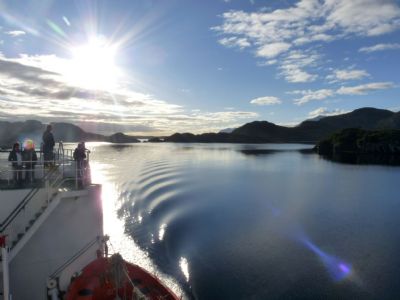
A brilliant early morning aboard the Navimag ferry.
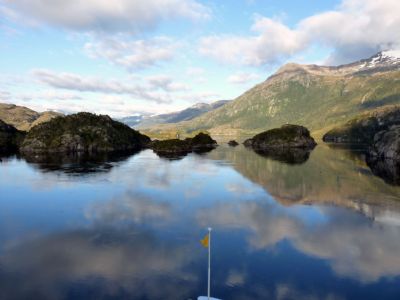
Some of the channels we went through on the Navimag ferry were very narrow!
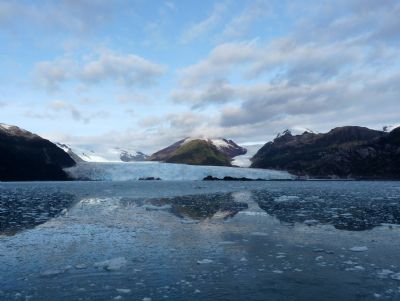
A glacier we passed on our journey.
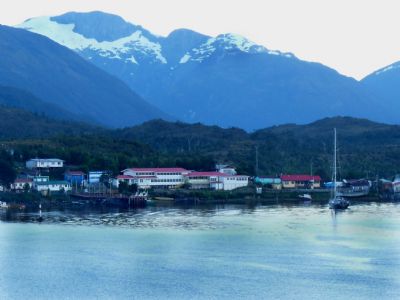
The remote Puerto Eden – the only settlement we passed in 4 days on the boat.
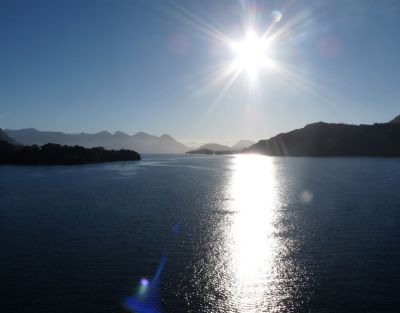
Another brilliant morning aboard the Navimag ferry.
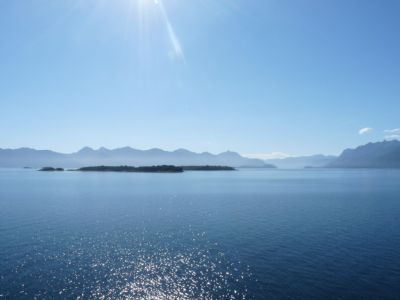
And another!
We arrived in Puerto Montt early on Saturday 26th Feb and managed (with some considerable difficulty) to find Hosptaje Corina where we were staying. We spent the rest of the day planning our next hikes, trying to get information (not very successfully) and buying food. Puerto Montt is very much "non tourist" Chile - somewhat run down and quite poor. The Chileans seem to really like huge portions of junk food (and this is reflected in their figures!). We ended up having some for lunch: half a chicken, a huge pile of fried onions and chips and to top it all 2 fried eggs!! All in all a bit too much!
5. Parque Nacional Alerce Andino (Chile)
The following day we took a local bus to Correntoso and then set off on the 13 km walk to the National Park Alerce Andino. It was blazingly hot and we were walking down a gravel road with no shade so it was quite hard work. Luckily for us, after about an hour a 4x4 stopped and gave us a lift the rest of the way. We then walked the 4 or 5 km to the area where we could camp. We were a little taken aback when the ranger at the Park entrance said it would take 4 hours! However, we soon realised why - the path was up and down and all tree roots and mud - quite tricky. Still we managed it in 2 and a half hours. We were walking through temperate rainforest, very dense with stands of Alerces - huge, ancient conifers. The oldest trees are said to be 4000 years old and have trunks with a diameter of 4 metres (the oldest we saw was 3000 years old according to the sign!) The campsite was effectively a wild site buried in the depths of the forest, very quiet and attractive but no views.
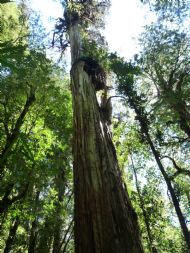
Some of the Alerces trees in the National Park Alerce Andino were 4.000 years old.
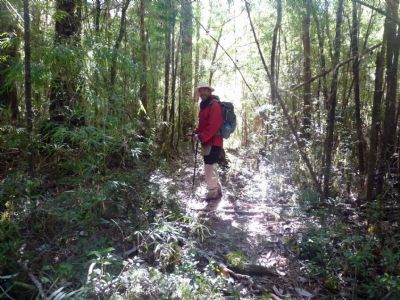
The temperate rainforests in the National Park Alerce Andino.
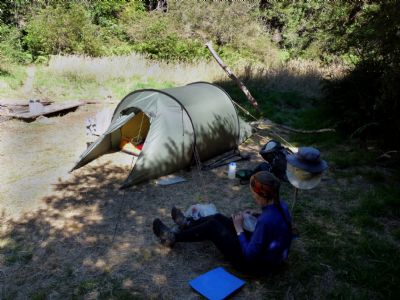
Our camp in the National Park Alerce Andino.
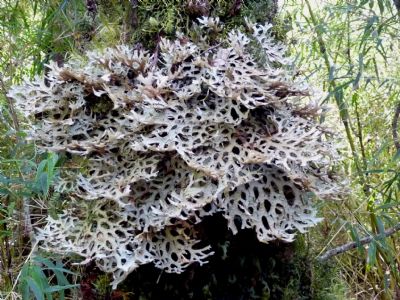
A wonderful lacy lichen in the park.
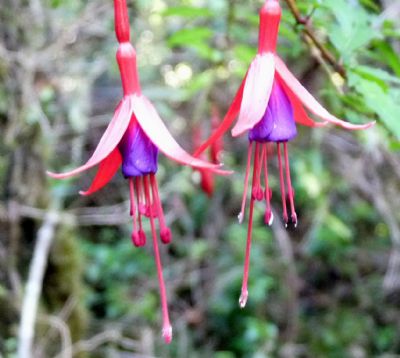
Fuschia bushes were flowering profusely.
The following day we left the tent and did a day walk to the attractive Laguna Fria. This involved crossing some amazing log bridges and was pretty muddy again. In the forest we were surrounded by wild fuchsia bushes absolutely smothered in flowers. If you were lucky you could see humming birds hovering by the flowers to get the nectar. The next day we walked back out of the park and then onto Correntoso (no luck with a lift this time!) and then caught the bus back to Puerto Montt - a tough day since it was VERY hot again.
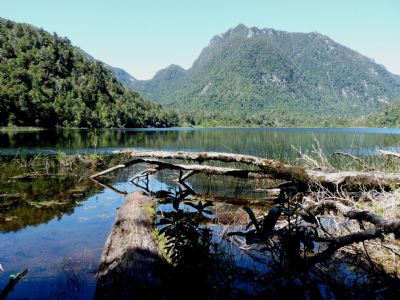
Laguna Fria, a lake deep in the wooded National Park Alerce Andino.
6. Parque Nacional Chiloe (Chile)
The following day we caught a long distance bus to Castro the largest town on the island of Chiloe (which is the largest island in Chile). We then jumped onto a small local bus to Changuin on the western coast and at the entrance to the Parque Nacional Chiloe. We camped there and then walked along the coast, mainly on a huge beach to a bay at Rio Cole Cole where we camped. It was fantastic weather and the beach and headland which we crossed to get to Cole Cole were quite something and totally empty. Cole Cole itself was totally stunning - a bay with a sandy beach surrounded on both sides by craggy headlands. We camped by the refuge under the shelter of the forest but with views out over the bay. The sunset there was quite incredible.
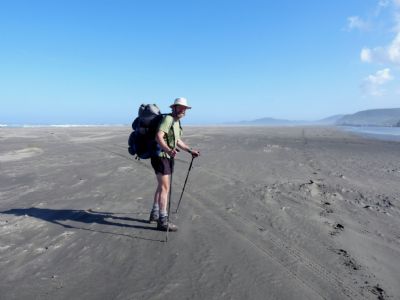
The HUGE beach en route for Cole Cole.
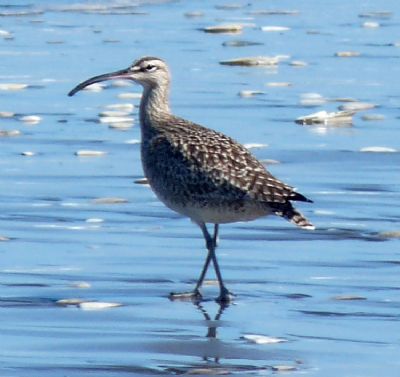
A wader on the beach.
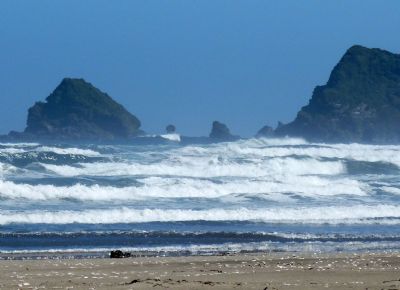
The wild Pacific Ocean.
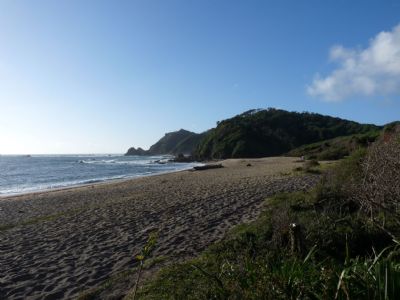
The bay at Cole Cole was very idyllic.
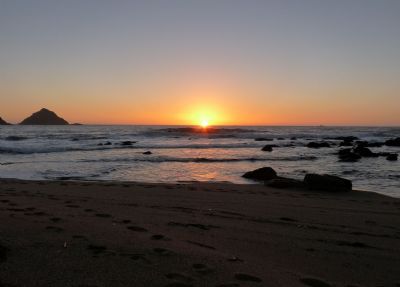
The beautiful sunset at Cole Cole.
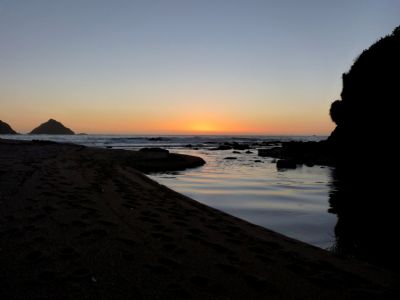
The beautiful sunset at Cole Cole went on getting better and better.
The next day we tried to do a day walk to Rio Anay. Unlike the path to Cole Cole, this one was totally unmaintained and so involved fighting our way through dense bamboo thickets as well as wading streams and really muddy bogs. Often the path, such as it was, was blocked by huge fallen trees and you had to find a way to clamber over or under them to get through. After almost 3 hours we still had not reached Rio Anay so we gave up, ate lunch and turned round. The next day we walked out and then the day after we went by bus to Ancud.
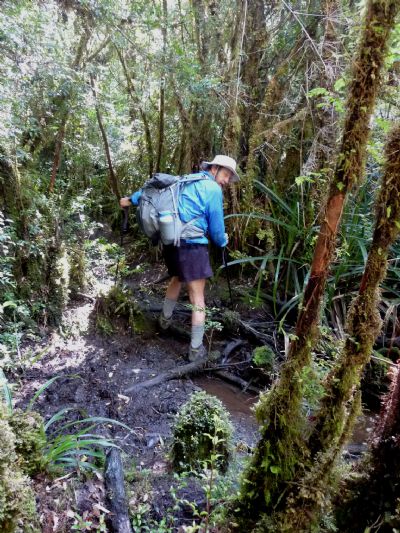
The muddy and difficult walk to Rio Anay.
One of the reasons we had decided to visit Chiloe was that it was possible to see penguins there (Tilly has always really wanted to see penguins!) and Ancud was the place to pick up the penguin tour. The tour was a great success. There were only 6 of us in the group and we visited the rocky islands where the penguins breed on a very small boat. There were masses of penguins and joy of joys, sea otters! Sea otters have to be one of the most laid-back animals ever. They just lay in the water floating on their backs with their paws in the air!! We found Ancud itself a bit depressing, not helped by a dinner where we had to wait 2 hours for the food but the wild life more than compensated for that. Then it was back to Puerto Montt for the last time to prepare for the next set of hikes.
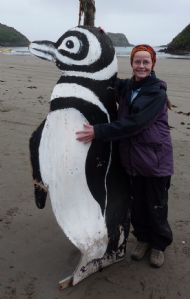
Tilly with a cut-out penguin where we boarded the boat.
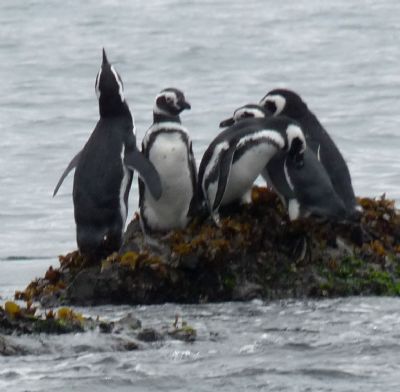
And the real thing – Magellanic and Humboldt penguins about 2-2.5 feet tall.
We took the bus from Puerto Montt to Osorno which is the regional capital of what is called the land of milk and meat. Osorno was full of little cafes offering "completos" which are huge hot dogs smothered in ketchup and mayonnaise. As mentioned before the Chileans love their junk food and their figures tend to reflect the fact. Strangely the names of the supermarkets echo this - the main one is called Bigger and the other supermarket in Osorno was called Jumbo!! We had been given some negative reports about Osorno but we liked it - partly because we found a really good place to eat - the Parilla de Pepe. Pepe complete with tall white chefs hat, cooked the BEST steaks we have eaten and his wine was top class.
7. Parque Nacional Puyehue (Chile)
We then took a bus to Anticura in the Parque Nacional Puyehue where we aimed to do 2 treks - Pampa Frutilla and Banos de Caulle. Up to this point we had been incredibly lucky with our weather but now it broke and there was a lot of rain and mist. We started with a 3-day trek to Pampa Frutilla (strawberry fields). It is called this because it is a high plateau with lots of wild strawberry plants growing. The weather on the trek out was not good so there were few views. Then it became really cold at night and we woke in the morning to find the tent encased in ice. The next day we left the tent at Pampa Frutilla and trekked up to a lake called Laguna del Paraitos. The weather started by snowing and then rained steadily, so we returned rather damp. On the 3rd day we trekked back to Anticura and the weather became quite sunny and nice giving us some good views of the surrounding volcanoes.
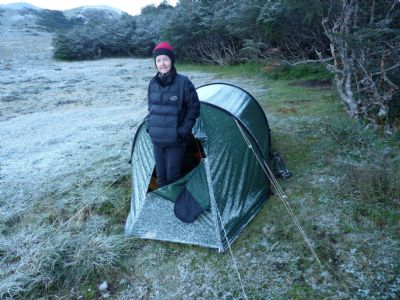
Cold weather at Pampa Frutilla.
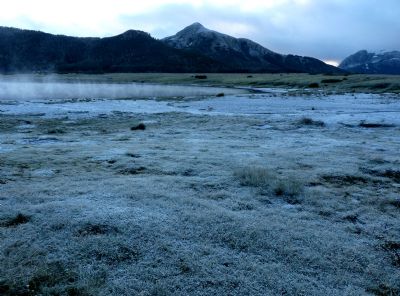
The icy view from our tent at Pampa Frutilla.
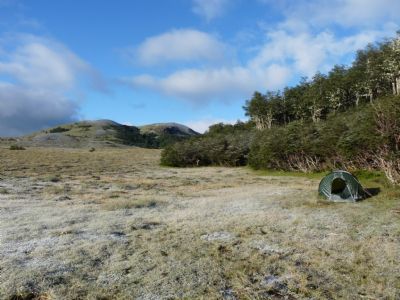
Wild camping at Pampa Frutilla.
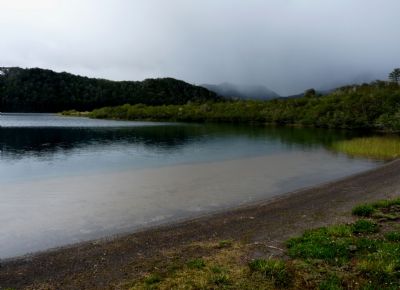
Laguna del Paraitos.
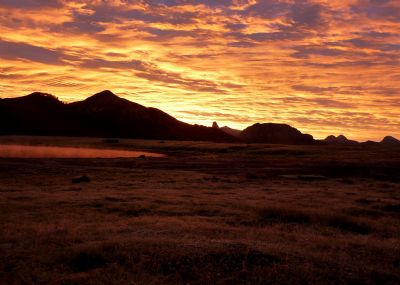
There was a great sunset on our last evening at Pampa Frutilla.
The following day we set off on the Banos de Caulle trek. This should have involved climbing up Volcan Puyehue and then trekking around the volcano to some geysers and bubbling mud tubs. This time we were well and truly thwarted by the weather. We climbed up to Refugio El Caulle on the flank of the volcano in mixed weather and decided to camp since the free refuge was full and rather dirty.
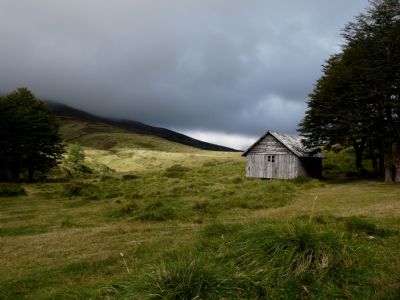
Refugio El Caulle on the Banos de Caulle trek.
We then found a real problem finding water. The slopes surrounding the volcano were all made up of cindery soil which seemed to be extremely porous. There were streambeds but they were all dry. In the end Martin found a pool in one of the streambeds which just about gave us enough water to survive. In the night there was a howling gale and torrential rain and when we woke in the morning we could not see anything - the clouds were down and we were in thick mist. We decided to give up and go down as the next section was easy to get lost on (no real path over a featureless cinderfield). The weather then improved and we found a really pretty place to camp for the night.
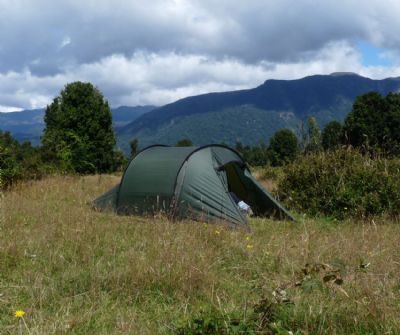
A better camping place down in the valley.
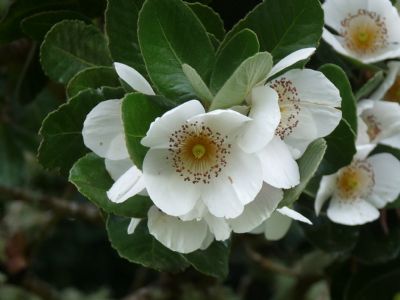
Beautiful flowers on trees.
The next day we followed a path alongside the Rio Gogol but the weather deteriorated rapidly and so we set up camp early. It then poured with rain for the afternoon, evening and night and was still raining the next morning. We decided to trek out and go back to Osorno a day early. We got to the road in good time for the bus but when the appointed time came no bus appeared. We hung on for another half an hour and then decided to hike down the road to Agua Caliante where we knew there were plenty of buses going to Osorno. The book said it was 12 km (in fact it turned out to be closer to 20km!!) We were going along OK when Martin suddenly developed a crippling pain in his left leg. Tilly decided to try hitching as we hobbled along now at a much reduced rate. We had no luck with the hitching but fortunately the pain in Martin´s leg improved and so we were able to keep going. Then a completely unscheduled bus came along and we managed to flag it down and get back to Osorno. Dinner at Pepe´s Parilla helped restore our spirits and deal with our calorie deficit.
Two days later we left Chile for the last time, taking the bus to Bariloche in Argentina, our last trekking base on the trip.
We booked ourselves into Hostel Patanuk - which turned out to have a laid-back hippy ambiance. There had been some confusion about the booking and so we ended up being up-graded into a veritable suite complete with a little kitchen and great views over the lake. Hostel Patanuk gave us the opportunity to cook for ourselves again, which had been impossible for most of the time in Chile and something which we were really missing.
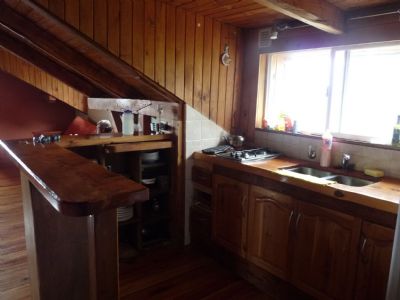
Our very own kitchen in our apartment at the Hostel Patanuk.
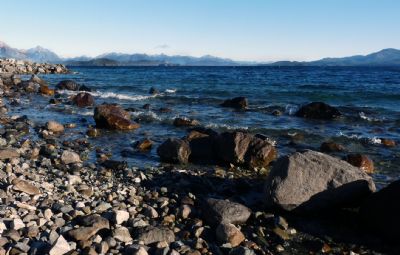
The Hostel Patanuk was in a great location right next to Largo Nahuel Huapi at Bariloche.
8. Nahuel Huapi Traverse (Argentina)
From Bariloche we wanted to do the Nahuel Huapi Traverse which needed good weather so delayed our departure until the weather forecast suggested that the weather would be sunny and windless on the really tricky third day. In the meantime we hired some mountain bikes and did what is called the Circuito Chico. This is a trip of about 37 km around the lakes just outside Bariloche - very scenic.
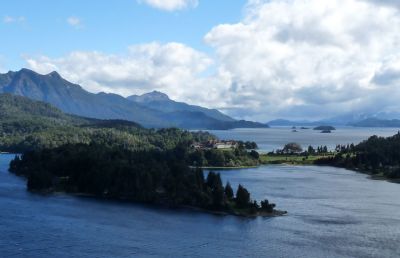
Villa Llao Llao – one of the great views on the Circuito Chico cycle tour from Bariloche.
We left Bariloche on the Tuesday morning catching the bus to Cerro Catedral to start the traverse. The guy who owned/ran Hostel Patanuk, who was a climber, advised us to take the longer valley route to the first refugio, Refugio Frey, since high winds were forecast and this could make the high level route uncomfortable to say the least. Subsequently we found lots of people had done the high level route without problems so felt we had been a bit wimpy!
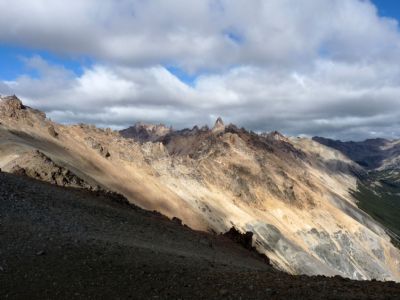
The first day of the Nahuel Huapi Traverse which we did subsequently as part of a 2 day walk.
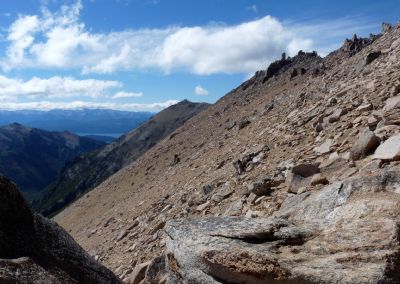
Looking back towards the start of the Nahuel Huapi Traverse.
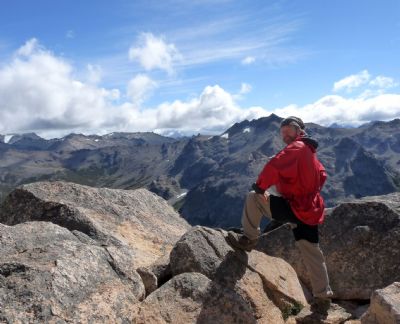
Martin takes up a confident pose!
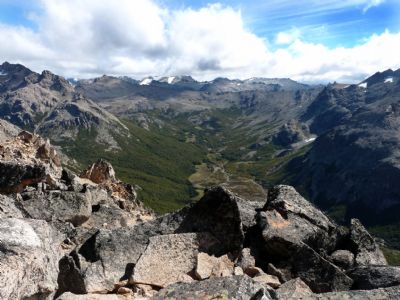
Looking down towards the valley we traversed on the second day.
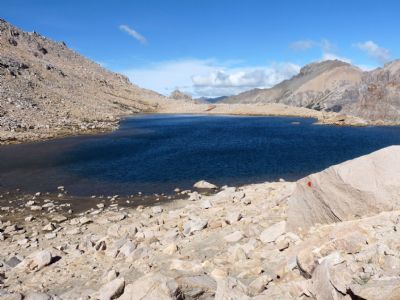
Descending to Refugio Frey.
Refugio Frey was a REAL mountain refuge, the first we had encountered in this trip. It was run by an exuberant Argentinian called Juan Manuel whose nickname was El Lechuga (the lettuce!!) He was about to move to London because he has fallen in love with a girl from Hong Kong who works and lives in London. He buttonholed us at every available occasion to interrogate us about life in London. Difficult to give a real impression to someone who has never lived in a city. The refuge was full - a mixture of people walking and climbing (there are lots of good but difficult rock climbs all around the refuge). It was all very jolly - the only problem was that the food was served at Argentinian times - so dinner did not arrive until 9.15 by which time we were dying of hunger!
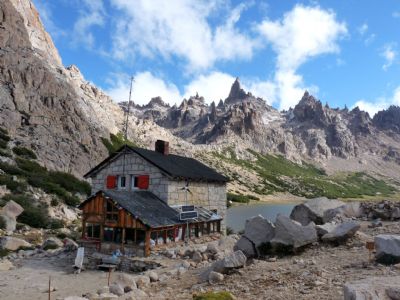
The wonderful Refugio Frey was in a stunning mountain location by a lake.
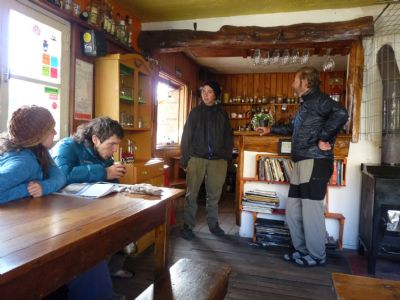
Inside the Refugio Frey.
The following day we walked to Refugio Jakob. The route was a real roller coaster - first climbing really steeply through frost shattered rock and then descending almost vertically through loose scree. Then there was a flat area with some open lenga (Southern beech) forest before we climbed vertically once again and then descended just as vertically to the refuge.
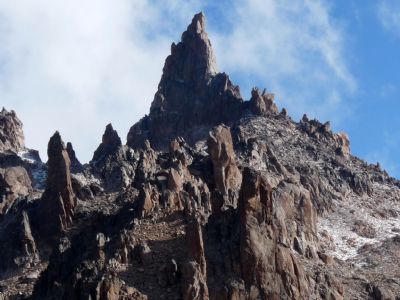
The peak of Cerro Catedral (2405m) which we passed by on our second day.
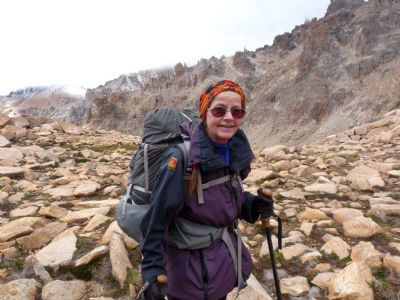
Tilly amongst the rocky landscape on Day 2.
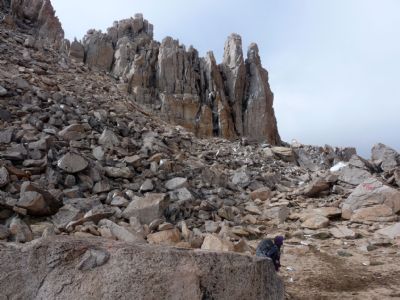
The pass of Cancha de Futbol on Day 2.
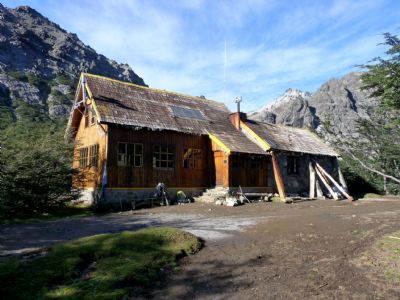
Refugio Jakob.
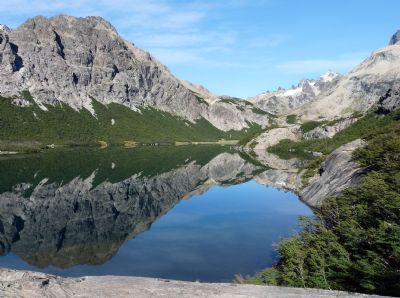
The Refugio Jakob was also situated on a lake. This was the view on the morning of Day 3.
We were undecided about whether to attempt Day 3 since lots of people had said how hard it was. In the end we went for it. The weather was perfect - blue sky, sun and no wind. We set off up a rocky ridge which gradually became steeper and steeper. Then we had to climb vertically up a rock face alongside a couloir (a steep gully) for 50 metres before climbing a loose scree slope to the ridge.
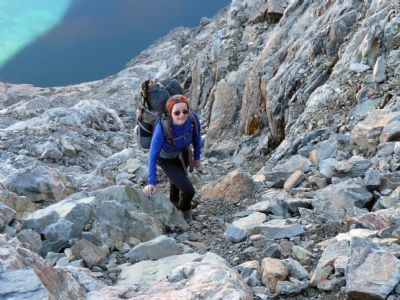
Tilly climbing up on Day 3.
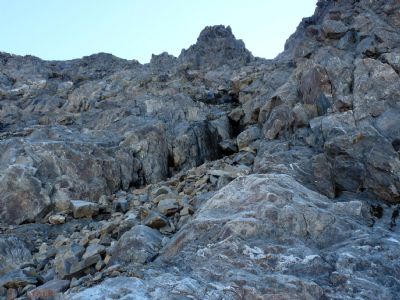
Looking up at our route on Day 3.
The landscape, which opened up before us, was incredible - a panorama of blasted rock pinnacles and steep scree slopes in all directions. One of the problems of the walk was finding the route since there was no path and very little in the way of markings - just the occasional cairn. Fortunately, we teamed up with a couple of guys from Manchester and a German and between us we managed pretty well.
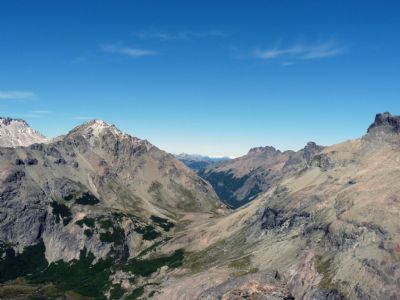
The view from the top of the couloir.
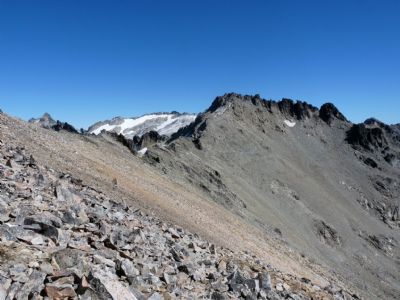
Our unmarked route lay along the scree slopes just below the ridge.
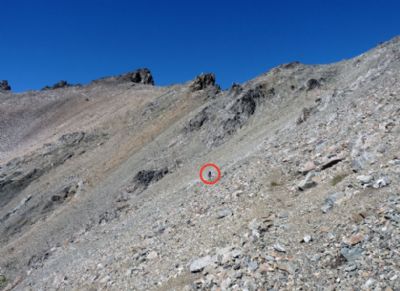
Looking back along the route. Tilly circled in red.
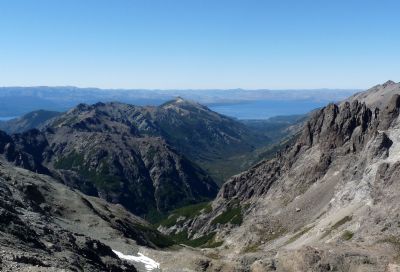
More of the views on Day 3.
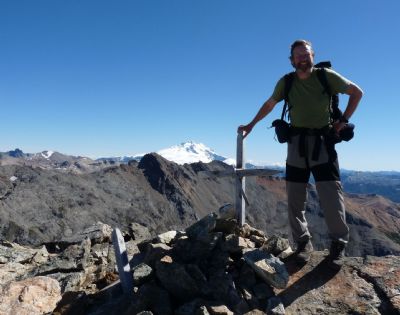
On top of Cerro Navidad (2060m). The white peak of Monte Tronador (3554m) in the background.
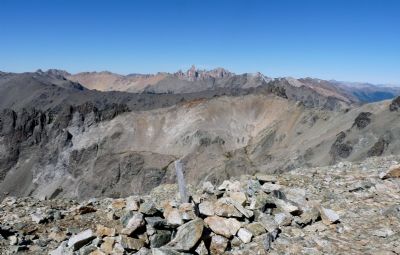
Looking back over the ridges we had climbed towards Cerro Catedral (2405m).
The walk was really gruelling - probably one of the hardest things we have done, particularly the last section of the descent down a river valley where we had to bushwack our way down a wild gorge. We arrived at Refugio Italia after eight and a half hours pretty exhausted.
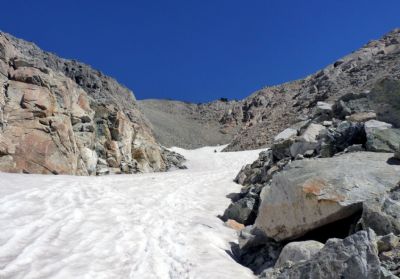
The descent from Cerro Navidad.
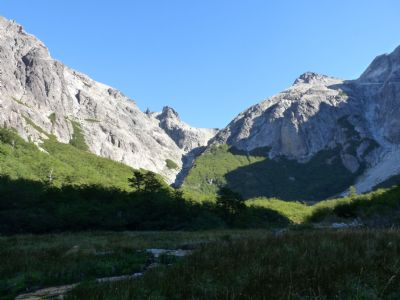
The descent from Cerro Navidad.
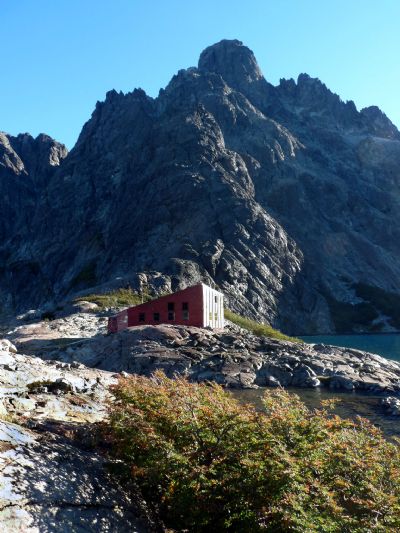
The welcome sight of the Refugio Italia.
The next day the weather had changed and was windy and wet with lots of low cloud. We decided to go on and it was another really hard day with the highlights being an almost vertical ascent of about 300 metres of loose scree slope and a vertical descent down rock faces. We were really glad to get to Refugio Lopez particularly as it was now snowing. We woke up the following morning to find everything covered in a thick blanket of snow. It made the mountains look really pretty and fortunately the path down was relatively wide and easy so we had no problems with the descent.
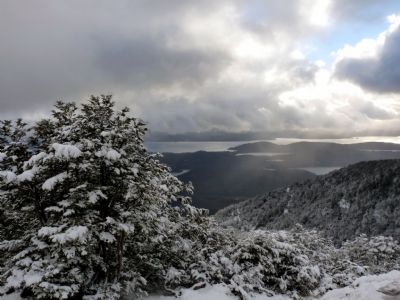
The view from Refugio Lopez on the last morning.
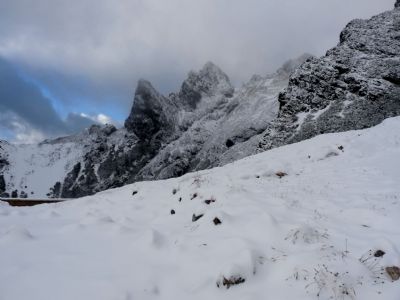
The view from Refugio Lopez on the last morning.
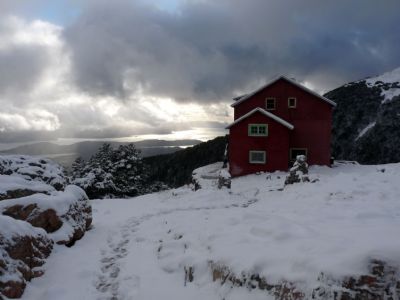
Refugio Lopez in the snow.
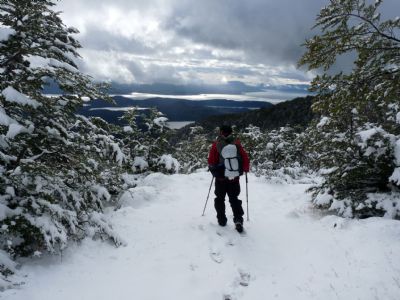
Starting our descent on the last morning.
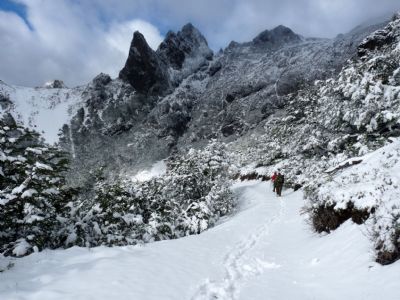
Our friends from Manchester on the descent.
The Nahuel Huapi Traverse was our last big walk in Patagonia. We did another couple of day walks in the same area and then it was back to Buenos Aires on a short flight. We had a couple of days in the big city feasting on great steaks and superb bottles of the Argentinian Malbec wine and then took the overnight plane to Paris and finally onto London. It had been a really great trip.
|    |
 Tilly and Martin's expeditions | sitemap | log in
Tilly and Martin's expeditions | sitemap | log in




















































































































